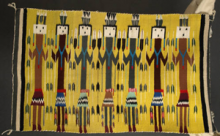Article
The Navajo people probably learned weaving skills from their Pueblo neighbors in what is now the Southwestern U.S. in the early 1600s. Traditionally it was women who mastered these skills, and used wooden looms, sheep's wool, and natural dyes to make hand-woven blankets that were used in everyday life as cloaks, covers, saddle blankets, etc. Throughout the 1700s, Navajo textiles became a major commodity in trading with the area's other Native tribes, as well as the Spaniards and other Europeans. Over time weaving techniques improved, patterns became more elaborate, and Navajo textiles came to be desired for their aesthetic value and became valued decorative pieces for non-Native collectors. Today hand-woven Navajo rugs are highly prized, and are often purchased by wealthy art collectors to be hung walls rather than used for the utilitarian purposes that were their origins.
"Ye'ii Navajo Rug, circa 1950," by Lucy Smith. (1990.01.375).Hubbard Museum of the West.
Manuscripts
References
Peck Kent, Kate
1985 Navajo Weaving: Three Centuries of Change. Santa Fe, NM: School of American Research Press.

